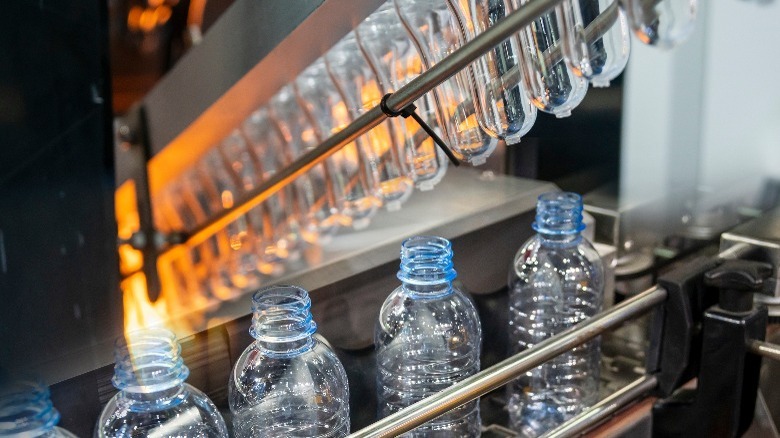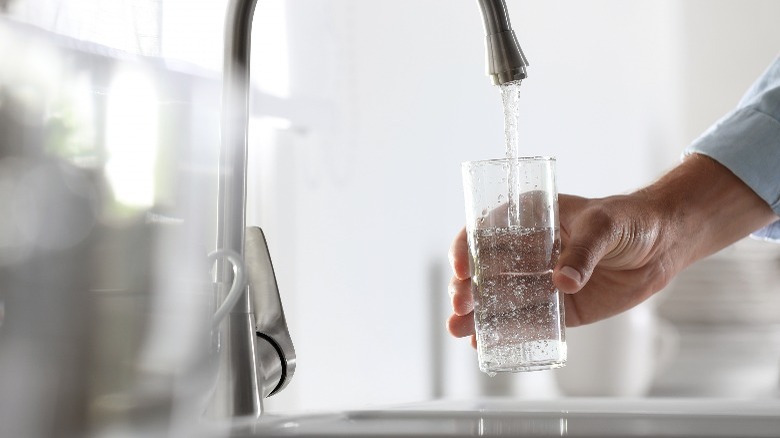Water Does Have A Taste, And That Taste Is Earth
Many think of water as the purest substance on the planet, yet anyone who has sampled more than one brand of bottled water or has drank from the taps of different locales knows that the most essential fuel of life has remarkably diverse tastes. While some water indeed tastes like nothing, other types of H20 present a distinct palette that can run from liquid manna to dirt. Generally speaking, water technically doesn't have a taste, but it usually contains additional elements that contribute to its flavor and texture.
Water in its most natural state contains a host of minerals that not only give it a distinct earthy taste but also make the drink healthier and more hydrating. That's because a bulk of these minerals are electrolytes like calcium, sodium, potassium, and magnesium, which help power cells and make the body more efficient at absorbing liquid. Natural water also contains other essential nutrients like zinc and iron, all absorbed through underground rocks in aquifers that harbor springs.
The taste of water depends on the source and processing
Water will taste differently depending on the mineral content of these natural sources. Some springs are higher in sodium, which means their water will be on the saltier side, while magnesium deposits give off a slightly sweet taste (which some describe as bitter or metallic if the content is high enough). Ironically, this means that the water we think of as the "purest," as in the stuff harvested from springs and other natural sources, actually has the most additional minerals inside.
In contrast, the bottled water that distributors filter is more devoid of minerals, although brands will often add minerals after the filtration process in order to enhance the taste. Not all bottled water is sourced and packaged the same, either; the types of labels that water companies use indicate how they're acquiring their water. While the "spring water" of regional brand bottles like Deer Park, Arrowhead, Ice Mountain, and Poland Spring is, in fact, harvested from regional springs, "purified water" like Aquafina, Dasani, and Nestle Pure Life is filtered from municipal sources like wells and taps. On the fancier side, "artesian water" like Fiji and Voss comes from underground aquifers.
Not all tap water is equal
The wide variety of ways in which companies bottle and distribute water means that each one will have its own unique taste. The closest water comes to being truly "pure" is when it's distilled through the process of boiling, although this isn't necessarily the healthiest way to hydrate since the beneficial minerals are gone. Tap water, contrary to some beliefs, is also perfectly fine to consume despite containing additional elements. Like bottled water, tap water's taste depends on where it's sourced and what additives water processing plants cleanse it with. Chemicals in pipes that carry the water to sinks (which are usually harmless) can also contribute to the flavor.
For instance, New Yorkers love to sing praises about how their city's tap water is the best in the country, although it's not because of the fluoride like many claim it is. It's probably because the Catskills Reservoir — which provides 40% of New York's drinking water — has a distinctly "pure" taste, evidenced by complaints from those whose home taps temporarily switched to the New Croton Reservoir when the Catskills source was under construction. The limestone deposits and higher (harmless) bacteria growth due to warmer temperatures in Croton made the water seem musty to those used to the Catskills. In another example, the higher sulfur content in Florida sources makes the state's tap water unpleasantly odorous to many. Suffice it to say that water has a seemingly endless assortment of flavors.



